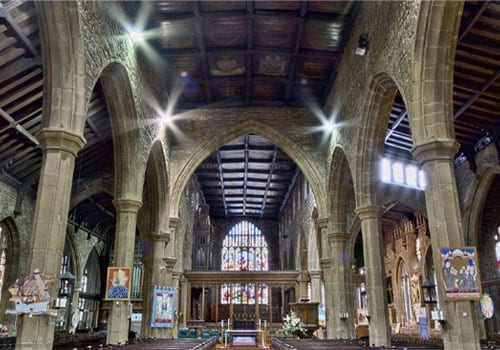When a building has been standing in place for a hundred years or longer, such as a church, the methodology for revamping the heating system and ensuring the comfort of patrons has to be more carefully considered for a number of reasons.
Older church buildings can have poor insulation levels and leaky envelopes due to age.
Building materials today are generally better insulators than materials of the past – usually simple brick, stone, earth, and timber — but even relatively modern materials will lose their ability to insulate over time. As materials contract and expand, gaps form in the envelope of the building. Since most church restorations use similar materials to the ones used originally, old buildings will regularly be at war with leaky envelopes.
In the case of stone churches, the very structure of the church imparts a high thermal mass.
Since churches are typically not in daily use, this thermal mass must either be overcome during use, or a comfortable temperature must be maintained season-round. Both are relatively expensive solutions.
Old HVAC systems are inefficient or operate poorly, and historic preservation regulations may limit modifications and upgrades to the building’s HVAC systems.
The fix most engineers would prefer for an HVAC system that’s a hundred years beyond it’s reasonable life is ripping the whole thing out and starting over. While some elements of the HVAC system may be able to be replaced, other sections might be protected by historic preservation regulations. This makes a true retrofit a more tedious endeavor at best and impossible at worst.
The large multi-story open spaces allow for stratification to form, which is a huge waste of heating energy and impacts comfort.
When engineers talk about buildings likely to stratify, a church is a perfect candidate. Stratification risk increases with high ceilings, large volumes, and leaky envelopes. We see issues with stratification regularly when churches use conditioned air to regulate temperature. Destratification not only saves energy and increases comfort, but it can also speed up the conditioning of the space during a morning warm-up cycle before service. In this case, the rising warm air is being captured and delivered to floor level, providing an immediate increase in comfort. Without fans, the building would heat from the “top-down” as the heated air rises and collects in the ceiling.
How Stratification Affects Old Churches Air Temperatures
Thermal stratification is a natural occurrence: hot air rises and cold air sinks. Your building’s HVAC systems are engineered to maintain a comfortable temperature on the floor and often overheat to compensate for stratification!
When your heater is running, heat rises and accumulates at the ceiling of your building, increasing the temperature and rate of heat transfer at the roof.
Conversely, cooled air from your air conditioner is heavier and will tend to sink to low points in a building or become trapped in difficult to circulate areas.
Airius fans are specifically designed to save you money and increase comfort. The fans continuously and gently mix the air, balancing temperatures (destratification) from ceiling to floor and wall to wall which helps the HVAC system maintain the desired temperature. No longer will you overheat or overcool a space, significantly reducing energy costs and dramatically increasing comfort.
Solving Church Heating And Air Issues Cost-Effectively
Working on a historic building can be a dream or a nightmare for an engineer. Fortunately, there are a few solutions you can cost-effectively implement.
- Take care of your envelope first. Make sure the conditioned air is staying in your building. Whenever possible, spend the first dollars of your budget on easy fixes like sealing windows and doors or replacing them. Remember that the building’s envelope can have leaks that aren’t immediately perceptible, like gaps where insulation in the walls has settled.
- Clean ducts, filters, and upgrade your heating system if it is in ineffective.
- Consider destratification fans to reduce stratification and increase comfort. While certain solutions may be constrained by historic preservation regulations, i.e. a church may be prohibited from running new ductwork, modifying existing return and supply locations, etc, destratification fans as a means of air distribution do not require any modifications at all to the building. This makes fans an important means of increasing air distribution and the effectiveness of the overall heating system.
Selecting an Airius Fan for your Church Remodel
For architecturally sensitive spaces, consider our Designer Series fans that can be custom painted to match your ceiling color. For ceilings around 50′, we offer the Q Series, our quietest model at that height. For dropped ceiling areas, check out our Air Pear Suspended Ceiling fans. Worried about odors, viruses, bacteria or VOCs? We offer a factory installed PHI cell for your fan system.




Leave A Comment
You must be logged in to post a comment.